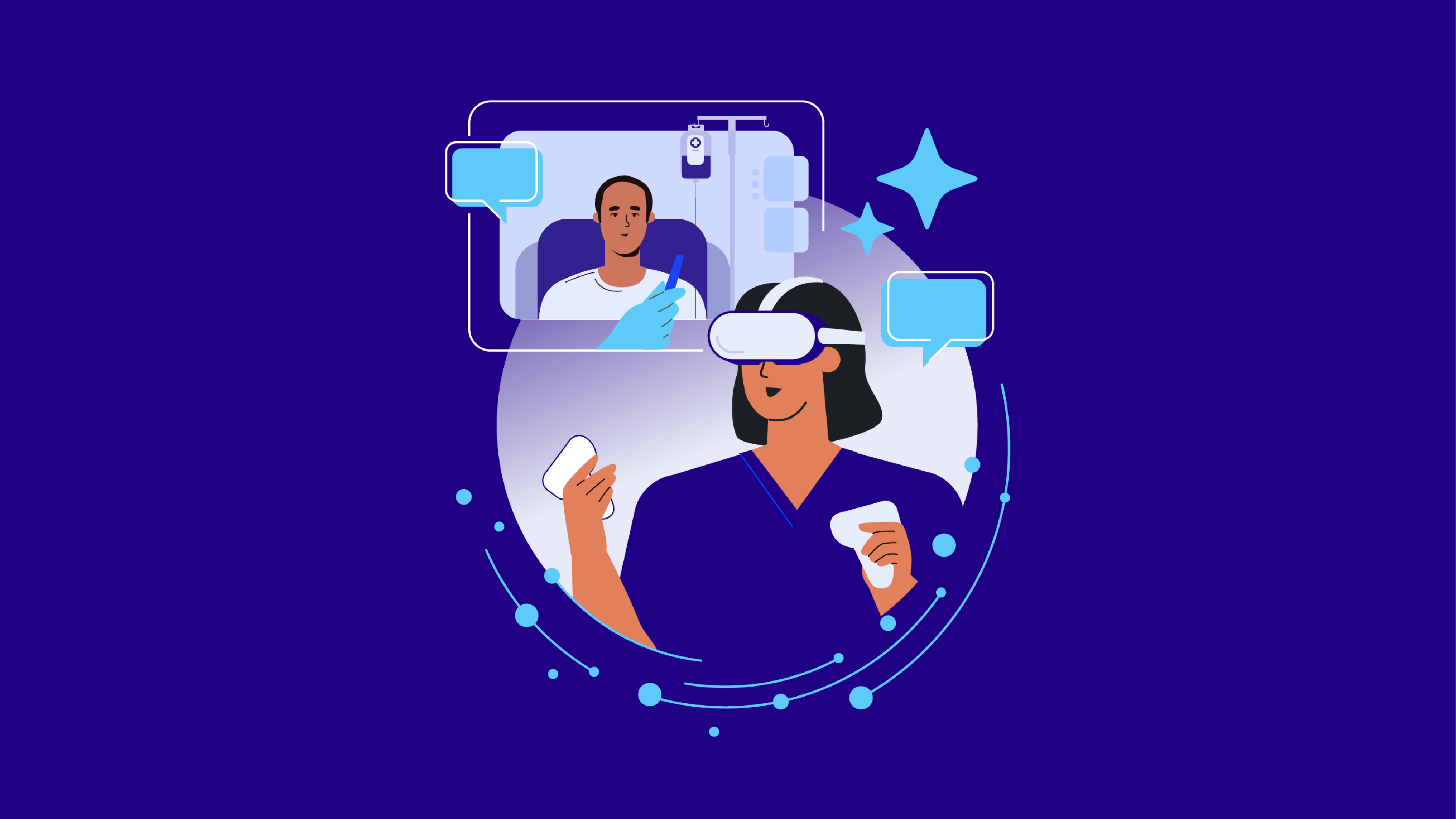How to Integrate VR Simulation Into Every Semester of Your Nursing Program

Table of Contents
Name of the heading
1- Start your table with the syntax {start-table}
2 - Add an H3 Heading to create a new column (this will be the column title)
3 - List cells as bullet points in a List element
4 - End your table with the syntax {end-table}
There’s a big difference between your first-semester nurse learners and those further along in the program. Early learners are often anxious about interacting with their first patients and overwhelmed by the workload. By the third semester, students typically have clinical experience and shift their focus to developing clinical judgment, especially around medication administration, and honing their therapeutic communication skills.
Whether your students are just starting Fundamentals or gearing up for advanced clinical judgment in Med-Surg, virtual reality (VR) can be a powerful tool to meet them where they are.
UbiSim, the VR simulation platform where nursing gets real, is here to give you and your students a back-to-school booster.
First Semester Learners
For learners in their first semester, typically enrolled in Fundamentals and Health Assessment, everything is new. From clinical skills like vital signs to communicating with patients, this group needs a gentle, guided introduction.
Top Challenges:
- Anxiety about their first patient interaction
- Lack of clinical skills and confidence
- Trouble communicating with patients
- Unfamiliarity with hospital environments and fast-paced coursework
How UbiSim Helps:
- Pre-made Tutorials: First-time users get guided tours of the hospital room, infusion pumps, PPE, and more, with step-by-step voice support.
- Fundamentals Scenarios: Scenarios like Health Assessment and Safe Med Administration in Alzheimer’s Care help students practice key skills in a low-stress setting.
- Repetition without Pressure: Students can repeat scenarios as many times as needed, building muscle memory.
- Peer Practice: One case study showed students even practiced at home with family members facilitating—no clinical expert required.
Why It Works
Students get their first exposure to auscultation, communication, and clinical decision-making before stepping foot in a hospital. This reduces anxiety and boosts confidence. Instructors report that students are more prepared when they show up to clinicals.
Second & Third Semester Learners
By now, learners have been through at least one clinical rotation and are taking more complex courses like Med-Surg and Pharmacology. The challenge? Making the leap from memorizing facts to applying them in real time.
Top Challenges:
- Struggling to apply theoretical knowledge
- Interpreting labs, imaging, and EKGs
- Learning clinical judgment around medications
- Developing empathy and patient education skills
- Re-engaging after long academic breaks
How UbiSim Helps:
- Med-Surg 1 & 2 Scenarios: From fluid & electrolyte imbalances to HALO events, learners encounter real-world complexity.
- Customizable Case Files: EHRs, lab results, imaging, all customizable for your curriculum.
- Medication Safety Scenarios: Students calculate doses, read labels, and make judgment calls like checking blood pressure before giving antihypertensives.
- Therapeutic Communication Practice: Learners role-play conversations where they must use plain language and empathy to connect with patients.
- Lecture Integration: Use VR to break up lecture time by casting a scenario live (e.g., fluid imbalance in a COPD patient), reinforcing key concepts in context.
Why It Works:
Learners start seeing patients as whole people, not just symptoms. By building empathy and sharpening clinical judgment in a realistic environment, they’re more likely to retain information and care deeply about applying it.
Ready to Boost Your Fall Cohort?
VR simulation isn’t just for tech-savvy programs or advanced students. With UbiSim, you can integrate immersive learning into every semester, from the first vitals check to complex med-surg scenarios. It’s repeatable, customizable, and scalable, whether you have one headset or a whole lab.
Here’s how to get started:
- Assign Tutorials before first sim days.
- Use Scenarios that match each course level.
- Encourage Peer Practice to increase access.
- Customize Scenarios to meet your curriculum needs.
- Use VR to Reinforce Lecture Topics and keep learners engaged.
Your students are coming back to class with big dreams and some big fears. Give them the tools to build confidence, compassion, and clinical judgment with immersive VR that prepares them for real clinical practice.
FAQs
Heading 1
Heading 2
Heading 3
Heading 4
Heading 5
Heading 6
Lorem ipsum dolor sit amet, consectetur adipiscing elit, sed do eiusmod tempor incididunt ut labore et dolore magna aliqua. Ut enim ad minim veniam, quis nostrud exercitation ullamco laboris nisi ut aliquip ex ea commodo consequat. Duis aute irure dolor in reprehenderit in voluptate velit esse cillum dolore eu fugiat nulla pariatur.
Block quote
Ordered list
- Item 1
- Item 2
- Item 3
Unordered list
- Item A
- Item B
- Item C
Bold text
Emphasis
Superscript
Subscript
Explore more

From 30 Minutes to 3: How AI Enhanced Analytics Transforms Debriefing Preparation
AI Enhanced Analytics: Scenario Performance Data now available in UbiSim's Version 1.19
.jpg)
Behind the Scenes: How We Brought Incisions & Dressings to Life in VR
How the UbiSim team built a VR system displaying 300+ distinct incision states—balancing clinical accuracy, technical constraints, and nursing education needs.
.jpg)
Step Inside the Room of Errors: Playful Exploration, Serious Skills
Learn how UbiSim's Room of Errors transforms nurse training through investigative play. Students spot hidden safety risks and build situational awareness.




